13 scenic cranberry bog walks in the Buzzards Bay region
Nothing says fall in the Buzzards Bay region quite like the annual cranberry harvest. As the leaves change colors each autumn, local cranberry bogs glow red with ripe berries that float on the surface of flooded bogs, ready to be harvested.
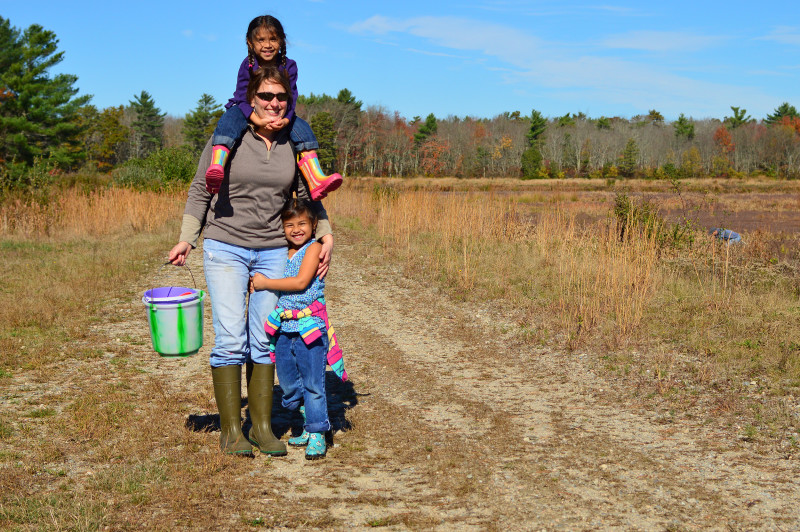
Families can explore The Bogs’ wide, sandy trails for frogs, birds, dragonflies, and wild-growing cranberries.
The cranberry industry is an integral part of the Buzzards Bay region’s economy and culture. About 20 percent of the nation’s cranberry crop is grown here – concentrated mostly around the head of the Bay, including Carver, Plymouth, Rochester, and Wareham.
Most cranberry bogs are privately owned, and are best viewed as you drive down local roads. But there are a few public spots where you can get a close-up view of a cranberry bog.
We’ve highlighted 13 local trails where you can take a walk by a cranberry bog. Check out one of these spots this fall and enjoy the view!
1. The Bogs (Mattapoisett)
At the heart of the Mattapoisett River Reserve lies The Bogs, a natural oasis located just minutes from Interstate 195 in Mattapoisett. The Bogs, which is owned by the Coalition, is a gateway to more than four miles of trails through the woods, along a scenic freshwater swamp, and around 50 acres of cranberry bogs.
The cranberry bogs at The Bogs were created in the 1930s and operated until the fall of 2011. Although these bogs are now retired from commercial production, native cranberries continue to grow wild here. With wide, flat trails criss-crossing the bogs and leading into the forest, The Bogs is a fantastic destination to take a walk and enjoy the outdoors.
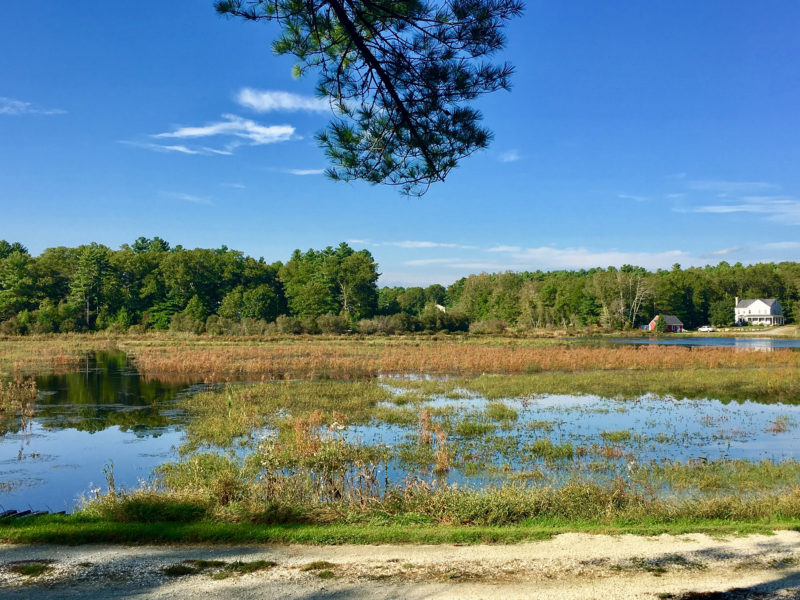
Stop and enjoy the view of a private cranberry bog from the trail at Lionberger Woods.
2. Lionberger Woods (Rochester)
Hidden within a quiet forest teeming with wildlife, the trails at Lionberger Woods offer you views of a placid cranberry bog located on private property next door. To catch a sight of this fall highlight at Lionberger, take the Raven Loop trail to its end at the western corner of the woods. If the weather’s nice, we recommend bringing in (and carrying out) a packed lunch to eat at the picnic table here for a meal with idyllic autumn views.
3. Doggett’s Brook Recreational Area (Rochester)
If you’re a Rochester baseball fan, you might have come close to Doggett’s Brook Recreational Area without even knowing it. The entryway to this park’s 100 acres of fields, forests, and waterways are tucked behind Dexter Lane baseball fields.
Abandoned cranberry bogs border the banks of Doggett’s Brook, the stream that runs along the southwestern corner of this parcel. Here in the woods, you’ll also find a bright red pumping house that used to fill these bogs with water at harvest time. Although these bogs are no longer in use, their remnants serve as a home for wildlife.
4. Rocky Gutter Wildlife Management Area (Middleborough)
With 3,000 acres of woods and freshwater swamps, Rocky Gutter Wildlife Management Area has something for everyone — from mountain bikers to hunters to nature photographers. For those in search of blazing red cranberry bog views, Rocky Gutter has them in abundance, too. This protected area is nearly surrounded by cranberry bogs to the north and east. Active bogs can be viewed at the south end of the trail that starts at the parking area. They’re also visible at the very north end of the property, accessible by a network of meandering old logging roads. Because this wildlife area is large and not always well-marked, we recommend any cranberry spotters bring a compass to guide them on their walk.
5. Charles R. Washburn Memorial Park (Marion)
In 2003, the Coalition and the Sippican Lands Trust worked together to add 109 acres of conservation land to Marion’s popular Washburn Park, the home of summer baseball games, a dog park, and even equestrian events like the Marion Horse Show. These additional lands include pine forest, wetlands, and cranberry bogs that can be viewed from either of the two northern legs of the trail network. Some of the bogs are retired, with rich red cranberry leaves mixing with wildflowers and other plants, while others are actively harvested sites that fill with bobbing berries in October and November.
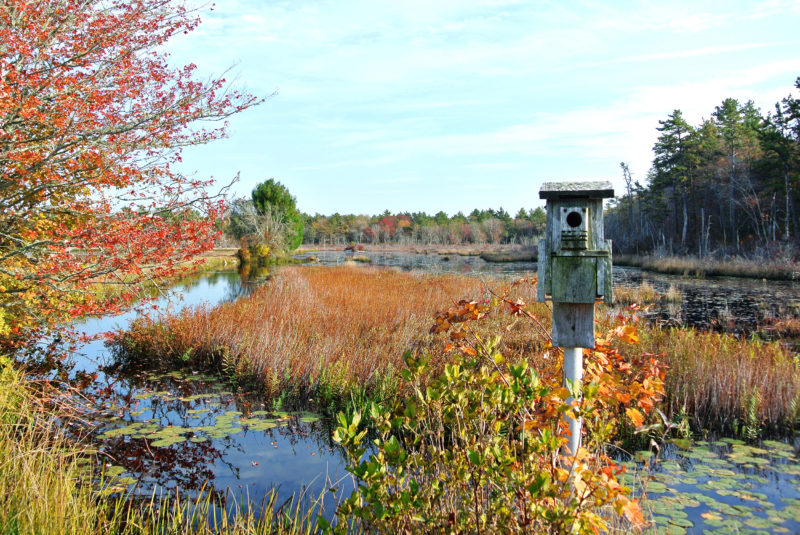
The White Eagle Parcel of Aucoot Woods in Marion has a wealth of freshwater wetland habitats set among vibrant cranberry bogs.
6. White Eagle Parcel (Marion)
Hidden away in the forests between I-195 and Route 6 in Marion, the Sippican Lands Trust’s White Eagle property offers plenty to explore. This 248-acre property is the largest protected area near Aucoot Cove, and its centerpiece is a retired cranberry bog. Flat paths around the bog cells provide wide-open views of the bogs and surrounding forests and wetlands.
The cranberry bogs at White Eagle are no longer harvested. Instead, they provide habitat for rare species like spotted turtles, eastern box turtles, and a species of moth called the water-willow stem borer.
7. Westgate Conservation Area (Wareham)
Westgate Conservation Area might be one of Wareham’s prettiest spots. With 49 acres of woods along a scenic stretch of the Weweantic River, Westgate is the perfect place to take a quiet weekend walk.
Nestled in the woods sit four cranberry bogs, with wide, flat paths in between and along the edges. These cranberry bogs are abandoned, so they’re no longer harvested. But birds, turtles, and other wildlife flock here, making the bogs a beautiful place to enjoy nature.
8. Great Neck Conservation Area (Wareham)
Two connected loop trails let walkers choose their own adventure at Great Neck Conservation Area. These two trails, each roughly two miles long, pass through a variety of beautiful habitats. This includes the remnants of a cranberry bog that was planted along Crooked River. Cranberry plants still turn rusty red here every autumn, growing among the cattail-filled wild marsh that has returned around them.
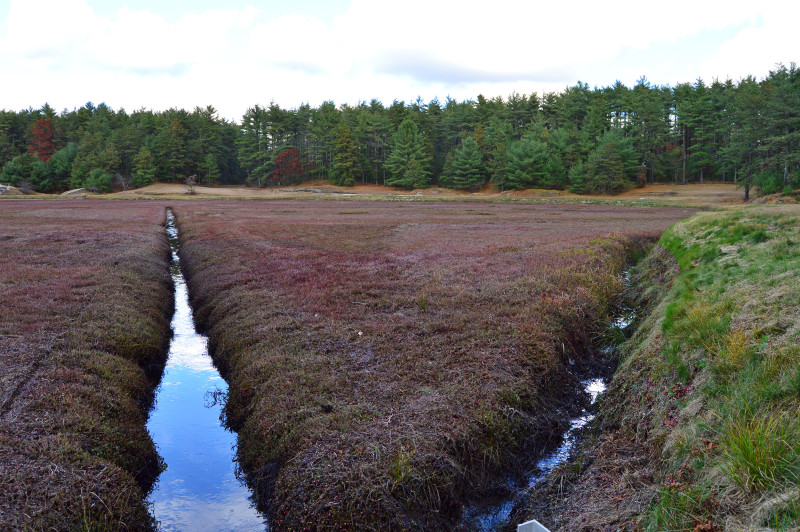
A cranberry bog in Myles Standish State Forest glows red in autumn after the harvest.
9. Myles Standish State Forest (Carver/Plymouth)
The largest publicly owned recreation area in southeastern Massachusetts — Myles Standish State Forest — is also located smack-dab in the middle of cranberry country. Sprawling across the southern sections of Carver and Plymouth, Myles Standish offers 13 miles of hiking trails through the forest.
Cranberry bogs welcome visitors at the west entrance to Myles Standish, located on the aptly named Cranberry Road. You can also catch a glimpse of bogs along one of the forest’s extensive bridle trails. In summer, Myles Standish offers interpretive programs that allow families to explore cranberry bogs and learn about their history, including how these bogs helped America win its independence by producing iron used in cannonballs.
10. Bourne Sisters Woodland (Bourne)
Looking for a short but challenging fall hike? Despite being just over half a mile, the Loop Trail at Bourne Sisters Woodland will take you up and down steep slopes that can get your heart pumping. When you reach the far side of these hills, you’ll be rewarded with an overlook that provides vistas of a bright red working cranberry bog. This bog and the brook that feeds into it are also a popular bird-watching spot, so take a moment before you continue your hike to look for local favorites like red-shouldered and red-tailed hawks, ducks, and great blue heron.
11. Red Brook Pond Conservation Area (Bourne)
Red Brook Pond Conservation Area is a nature photographer’s dream, particularly in the fall. At the start of the trail, several lookout points over Red Brook Pond offer views of glassy water reflecting the vibrant colors of fall leaves, with benches set in place so that you can relax and take in the best of autumn’s vibrancy.
Continue onward and you’ll find another treat: these loop trails circle one working cranberry bog and run along the borders of another, with several more benches for you to stop and enjoy the view of them. If you’re lucky enough to visit when these bogs are flooded for harvest, the sight of thousands of red berries floating beneath a bright blue sky is quite a sight to see.
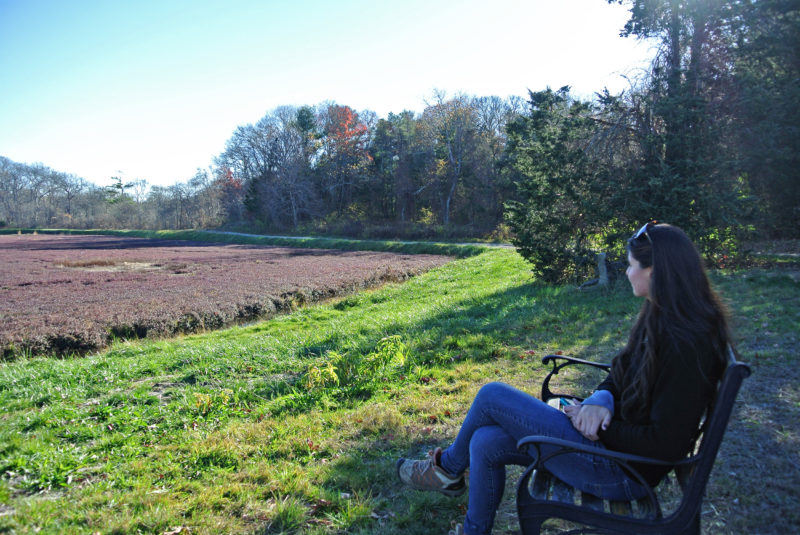
Sit beside the bogs at Cataumet Greenway and watch for wildlife that likes to stop over in this wetland habitat.
12. Cataumet Greenway (Bourne)
A single trip isn’t nearly enough to do justice to the series of interconnected woods and wetlands at Cataumet Greenway — we recommend a few trips to explore this winding network of trails. If you’re in search of cranberry reds, start your adventure from the trailhead at the intersection of County and Shore roads and walk along the horse farm at Dimmick Field. Red arrows point the way towards the bog, which is actively harvested every fall.
13. Shining Sea Bikeway and Wing Pond Woods (Falmouth)
Falmouth’s Shining Sea Bikeway is home to scenic views of marshes, ponds, harbors, and coastal beaches. And if you’re looking for a cranberry bog, you can find one of those along this easily accessible 11-mile Cape Cod trail.
About two miles south of the bikeway’s northern entrance, the path cuts through a privately owned cranberry bog at Wing Pond Woods. Cranberries have been harvested here each fall for over 100 years. If you time your trip right — around mid-October — you may be lucky enough to see an up-close view of the harvest. Around dusk, the bog is a great place for wildlife watching: foxes, rabbits, bats, and deer are often spotted here.